- Technical Note: "A Beginner's Guide to Nutrition on the Small Farm"
- Nutrition Research Program
- A Simple Way to Improve Starchy "Weaning Foods"
- Can the Trypsin Inhibitor in Soybeans be Overcome by Germinating the Seeds?
- Relative Nutrient Values of Fruits
- A New Idea for an Emergency Milk Substitute in West Africa
- Moringa and Carotene
- Leaf Concentrate
- Book Review: Valor Nutritivo y Usos en Alimentacion Humana de Algunos Cultivos Autoctonos Subexplotados de Mesoamerica
- Booklet Review: Toxicity and Food Security: A review of health effects of cyanide exposure from cassava and of ways to prevent these effects
- Sweet and Bitter Cassava and Cyanide Content
- Are Raw Vegetables More Nutritious Than Cooked Ones?
TECHNICAL NOTE "A BEGINNER'S GUIDE TO NUTRITION ON THE SMALL FARM" by Dr. Frank Martin is a primer for those with little or no experience in this area. He offers some simple guidelines for a balanced diet. Discussed are nutrients in food, recommended daily allowances, individual differences and special needs, balancing the diet, and what to do when milk is missing from the diet. Available from ECHO.
NUTRITION RESEARCH PROGRAM at Judson College involves undergraduate biochemistry and cell biology students in nutrition-related research for developing countries. They have studied the toxin levels in velvet beans (see Chapter 11 on Human Health), and determined which methods are most suitable on the home scale; they plan to pursue similar research with jack bean. Interested students and others should contact Dr. Rolf Myhrman, Nutrition Research Program, Judson College, 1151 N. State St., Elgin, IL 60123, USA; phone 708/695-2500.
A SIMPLE WAY TO IMPROVE STARCHY "WEANING FOODS." The following is abstracted from information provided by Noel Vietmeyer (U.S. National Academy of Sciences) in the June 1993 issue of Spore.
 "Throughout the developing world boiled starchy grains and roots are given as weaning food.... Boiled starch is so thick and pasty that it is difficult for the very young to swallow enough to gain adequate nourishment." Germinated grains release enzymes that break down starch (as in the process of malting). "A very small quantity of malted millet or sorghum flour added to a pot of mush made from corn meal, cassava, arrowroot, potato or other boiled staples turns it to liquid in minutes. It is liquid enough for the baby to swallow but dense enough to be filling. It is also more tasty because most of the starch has been converted to sugar." [Ed: Sprouted sorghum should not be eaten because of its cyanide content, but 2-3 grains should be harmless.]
"Throughout the developing world boiled starchy grains and roots are given as weaning food.... Boiled starch is so thick and pasty that it is difficult for the very young to swallow enough to gain adequate nourishment." Germinated grains release enzymes that break down starch (as in the process of malting). "A very small quantity of malted millet or sorghum flour added to a pot of mush made from corn meal, cassava, arrowroot, potato or other boiled staples turns it to liquid in minutes. It is liquid enough for the baby to swallow but dense enough to be filling. It is also more tasty because most of the starch has been converted to sugar." [Ed: Sprouted sorghum should not be eaten because of its cyanide content, but 2-3 grains should be harmless.]
We found further information in the book Food from Dryland Gardens, p. 332. It states that you can make 100 g of a millet porridge of suitable consistency for a weaning food that contains 25 kcal of energy and 0.4 gram of protein. On the other hand, 100 g of porridge of the same consistency made with addition of malt contains 83 kcal and 1.3 g of protein. We spoke with Mark Dafforn, Noel's assistant, for more details.
Q. Is this process actually used in some location among the poor or is it a totally newidea? Where did the idea come from?
A. Baby food manufacturers in developed countries routinely liquify their products, but it has a very short track record in developing countries. Noel found the recommendation in a technical report on a Swedish Development Agency (SEDA) project. It has been used in Tanzania and India, and the idea has now been picked up and is being tried in several other places. No one--including ourselves--has done a comprehensive look at its usefulness.
In a way, the concept of liquefying staples is like oral rehydration therapy (ORT) twenty years ago...an idea that was so simple it was ignored by scientists but picked up by desperate development workers--and since then ORT has saved hundreds of thousands of lives at a few pennies apiece.
Q. Does malting change the nutritional value of the porridge?
A. The porridge will be more runny, but that is because the water that was tied up in the starch is released. The starch is essentially predigested. All the original nutrients are still there.
Here is how malnutrition can develop if the porridge is not malted. Children in third world countries often go through a nutritional crisis when they are weaned. Babies are often weaned directly onto traditional adult porridges. Because babies have trouble swallowing the thick porridge, mothers dilute it with water. It can be so diluted that the child's stomach is filled without eating as much food as he or she should. Also, if unboiled water is used, disease organisms are introduced.
 Q. The directions said "a small quantity" per pot of mush. How much is a small quantity?
Q. The directions said "a small quantity" per pot of mush. How much is a small quantity?
A. Let's say a teaspoon, half a teaspoon, or even less malt for a big bowl. As you know, enzymes are catalysts which speed up reactions without being used up in the process. If you use less enzyme it will take longer. Of course, if the mush is really thick--think of dry mashed potatoes--it doesn't contain enough water to liquify in the first place.
Q. Where does one get malt? We used to buy malted milk shakes. Is this the same thing?
A. I think there's usually an important difference. In those malts the enzyme (called amylase) has been deactivated by heat so you get the flavor but you don't get runny milk shakes! (By the way, so little malt is used in liquefying staples that traditional flavors aren't overwhelmed.) You can usually purchase malt flour at health food stores. It's often called brewer's malt, because it's used to convert the starches in grains to sugars as the first step in making beer. By the way, please point out that though malt is used in brewing, it has no alcoholic content itself...that comes later, from fermenting sugars with yeast.
Q. Let's be very specific. When you used sprouted wheat, did you mash the fresh sprouts, or did you dry them first and then make them into a flour?
A. Well, actually I just crushed the fresh sprouts between my fingers, and stirred. The amylase content is reportedly highest just after the seed has softened and begun to burst.
Q. Are there other applications?
A. It can be used with people needing a liquid diet with a high nutrient density. A starch based dish like mashed potatoes can be liquified while still retaining its familiar taste. If your readers have other ideas or experiences, we'd be glad to know. Just ask them to drop a brief, informal note to us at the National Academy of Sciences, 2101 Constitution Avenue, Washington, D.C. 20418, USA. [End of interview.]
Isabel Carter, editor of Footsteps, provided additional details about using "power flour" to convert thick porridge into a sweeter, more runny food for infants. The following is abstracted from the September 1992 Footsteps. "Grains can be germinated by leaving them in water for a day. [Ed: They will not have spouted but the biochemical transformations involved in germination will begin.] During the sprouting process they develop high concentrations of amylase [the enzyme that converts starch to sugar]. Soak cereal grains (maize, rice, millet) for up to one day in a covered pot or bucket. Legumes such as mung beans, haricot beans and cowpeas can also be germinated. They need longer soaking--up to two days. Dry the grains well in the sun. If sorghum is the main cereal, this can also be used to make power flour, but it must be allowed to act for a few minutes, then the porridge must be cooked for a few additional minutes. Mill as usual for ordinary grains." They recommend using either cereal grain flour alone or a mix of 1 part legume to 2-3 parts cereal. Power Flour is available commercially in Tanzania as "kimea" and in India as "ARF" (amylase-rich flour).
This issue also had some interesting comments about fermented foods. Fermented cereals "are widely used in Africa. Fermented legumes are often used in Indonesia and other Asian countries. The advantage ... is that naturally occurring bacteria [make the food acidic]. This improves the taste and also has the advantage that diarrhoea-causing germs cannot grow so easily. ...Because of lack of time and fuel, mothers are usually not able to prepare fresh food throughout the day, especially for feeding young children who need several meals a day. In a recent study in Ghana, it was found that the number of diarrhoea-causing organisms in food prepared using fermentation was less than half that in food which had been prepared freshly, then left lying around. The fermentation process also breaks down some of the fiber in the food and increases iron absorption. [The traditional process lasts 48 hours, not long enough to produce alcohol.] Why have people stopped using fermented food? A study in Kenya suggests that health workers feel that traditional fermented foods are not modern, and should be discouraged." Footsteps always includes this kind of practical information. It is free to individuals working to promote health and development. Specify English, French or Spanish. Write to Tear Fund, Footsteps, 100 Church Road, Teddington, Middx TW11 8QE, UK.
CAN THE TRYPSIN INHIBITOR IN SOYBEANS BE OVERCOME BY GERMINATING THE SEEDS? In Chapter 9, we discussed treatment of soybeans to inactivate the trypsin inhibitor prior to feeding to animals. Someone wrote suggesting that sprouting might have the same effect without the need to use a heat treatment. We found an interesting article that looks at  various methods of preparing soybeans for food, including sprouting, in the Journal of Plant Foods, 1983, 5, 31-37, (1983). Whole soybeans were soaked in water at 50øC for 3 hours, then allowed to germinate for 3 days, with a daily spray of water. Seed coats were discarded (I presume to make them more acceptable in human diets) and beans were dried in a hot air oven. The trypsin activity dropped from 107.5 in raw soybean to 59.7 in the germinated product. In a feeding trial with rats, rats fed a casein control (a milk product with exceptionally high quality protein) gained 64 grams in 4 weeks, rats fed raw soybeans gained 20.5 grams and rats fed germinated soybean gained 42.8 grams. Unfortunately the article did not test soybeans that had been treated for use in commercial animal feed. This information would have been very helpful. What is my conclusion? Without more information, I would suggest that heat treatment is preferable, but sprouting is a lot better than using raw soybeans.
various methods of preparing soybeans for food, including sprouting, in the Journal of Plant Foods, 1983, 5, 31-37, (1983). Whole soybeans were soaked in water at 50øC for 3 hours, then allowed to germinate for 3 days, with a daily spray of water. Seed coats were discarded (I presume to make them more acceptable in human diets) and beans were dried in a hot air oven. The trypsin activity dropped from 107.5 in raw soybean to 59.7 in the germinated product. In a feeding trial with rats, rats fed a casein control (a milk product with exceptionally high quality protein) gained 64 grams in 4 weeks, rats fed raw soybeans gained 20.5 grams and rats fed germinated soybean gained 42.8 grams. Unfortunately the article did not test soybeans that had been treated for use in commercial animal feed. This information would have been very helpful. What is my conclusion? Without more information, I would suggest that heat treatment is preferable, but sprouting is a lot better than using raw soybeans.
RELATIVE NUTRIENT VALUES OF FRUITS. We made a "score" for each fruit by adding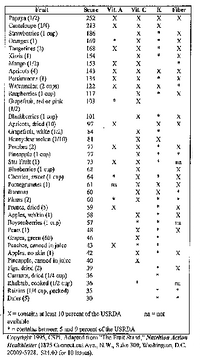 up its percent of the U.S. Recommended Daily Allowance (USRDA) for 9 nutrients plus fiber. (We printed only 3, because the others were usually low.) There is no USRDA for fiber or potassium (K), so we used 25 g for fiber and 3500 mg for K. For example, a quarter of a cantaloupe has 86% of the USRDA for vitamin A, 94% for vitamin C, 12% for potassium, 6% for folate, 4% each for fiber and niacin, 3% for thiamin, 2% each for iron and riboflavin, and 1% for calcium. After rounding, that adds up to a score of 213. Numbers for canned fruit are for two halves or slices, including the juice. If no number was
up its percent of the U.S. Recommended Daily Allowance (USRDA) for 9 nutrients plus fiber. (We printed only 3, because the others were usually low.) There is no USRDA for fiber or potassium (K), so we used 25 g for fiber and 3500 mg for K. For example, a quarter of a cantaloupe has 86% of the USRDA for vitamin A, 94% for vitamin C, 12% for potassium, 6% for folate, 4% each for fiber and niacin, 3% for thiamin, 2% each for iron and riboflavin, and 1% for calcium. After rounding, that adds up to a score of 213. Numbers for canned fruit are for two halves or slices, including the juice. If no number was 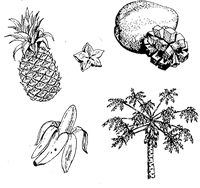 available for a nutrient, we assigned it a value of 0, which makes the scores for some fruits lower than they should be.
available for a nutrient, we assigned it a value of 0, which makes the scores for some fruits lower than they should be.
A NEW IDEA FOR AN EMERGENCY MILK SUBSTITUTE IN WEST AFRICA. Ken Flemmer with Adventist Relief and Development International sent us the following report from two of his staff, Jim and Yoko Rankin. It concerns a totally new use for the egusi melon.
During a training seminar in Ghana a local farmer stated "that his wife did not have sufficient milk to feed their 6-month-old baby. Our first thoughts went to soy milk, but as they do not have soybeans it was not a practical solution. Also, soy milk is not easy to prepare and becomes acidulated very quickly."
"Someone suggested agushi melon seed [Ed: this is surely a Ghanian spelling of egusi]. I set up the blender, took 100 grams dehulled agushi seed and blended it with two cups (400 ml) of water and tasted it, added another cup of water, 2 teaspoons of honey and 1/4 teaspoon of salt and behold, we had a milk tastier and creamier than soy milk with a closer texture resemblance to real milk."
"The dry dehulled seeds resemble a large pumpkin seed. In the village every home has stone mills or small grinding plates. The seeds are easily crushed into a peanut butter consistency. Mixed with water, honey and salt --instant raw milk. To make it equal to mother's milk we found that we must add 6/7 cup of water per 1 cup (100 g) dehulled seed. It does not form gas and the school children who have tasted it have not complained of any problems."
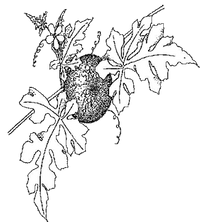 "The agushi melon grows throughout Togo, Ghana, Cote d'Ivoire and Benin [Ed: also Nigeria, Zaire and probably elsewhere]. One type has large seed and a very thin papery hull which slips off when seeds are rubbed between the palms of the hand. The other two types have a very hard shell on seeds that are slightly larger than cantaloupe seed. We have tried making milk from all three types, but the smaller varieties with hulls intact make a slightly bitter tasting milk. I presume that if the hulls can be removed the bitter taste would disappear."
"The agushi melon grows throughout Togo, Ghana, Cote d'Ivoire and Benin [Ed: also Nigeria, Zaire and probably elsewhere]. One type has large seed and a very thin papery hull which slips off when seeds are rubbed between the palms of the hand. The other two types have a very hard shell on seeds that are slightly larger than cantaloupe seed. We have tried making milk from all three types, but the smaller varieties with hulls intact make a slightly bitter tasting milk. I presume that if the hulls can be removed the bitter taste would disappear."
I mentioned all this to gardener Glen Munro in Indiana, lamenting that we had no idea how the "milk" tasted. Surprisingly, Glen had grown egusi in the summer and could do a few trials for us. Here are some highlights of his experience. Unlike in Ghana, he did not dehull the seeds.
"I blended 75 g seed, 1.5 cup water, 1/16 teaspoon salt and 1 teaspoon honey in our Osterizer blender at the 'liquify' setting. After straining I had 1/3 cup of meal and 1.5 cup of what looked like milk. It had a subtle raw cucumber-like taste. The meal was similar to corn meal mush with a distinct feel of some additional fiber and a raw flavor. After boiling the flavor was unchanged, but good. The flavor was a bit strong, but I believe I could adjust to eating it as a breakfast cereal.
"I repeated, using a Vita-Mix juice blender that more completely pulverized the seed, leaving out the honey. I then did a taste test with various additives, using 2% milk as a standard (rating of 5). The raw cucumber taste came through in all samples, but was hardly noticeable with Hershey chocolate syrup added (rating of 5-). After drinking 2 ounces, though, I noticed an itchy feeling in my throat, I think due to the fine fiber. Adding honey or maple syrup gave drinks that I rated as 4+."
The variety of egusi that ECHO distributes has seeds larger than watermelon seeds. Egusi, Citrullus lanatus ssp. colocynthoides, looks like a watermelon while growing, but the white flesh of the round, over 6-inch diameter fruits is bitter and inedible.
Of course, just because something looks and tastes like milk does not mean it can be a milk replacement. We found no information comparing the nutritional value of egusi to milk, but did find a very helpful article Chemical, Functional and Nutritional Properties of Egusi Seed Protein Products (J. Food Sci, 47, 829-835, 1982). We can send a copy if you are interested in that much detail. Dehulled seeds contain approximately 50% oil and 30% protein. They are good sources for the essential amino acids arginine, tryptophan and methionine, and vitamins B1, B2 and niacin and the elements sulfur, calcium, magnesium, manganese, potassium, phosphorous, iron and zinc. Egusi has potential as a source of calcium and niacin in low-milk-consuming regions.
Biological indices of protein quality were "lower than soybean but comparable to or higher than most oilseeds." The most limiting amino acids are lysine followed by threonine. "Histidine has been known to be an essential amino acid for infants. ...Thus the low content of histidine in egusi seed should be considered in the use of this product in food formulations, especially if the foods are intended for infants."
Heating the "milk" is going to be a problem. Glen writes, "as soon as the liquid felt hot to my finger it began to curdle. By the time it boiled it was clumped into 1/4 to 1/2 inch (0.6-1.2 cm) diameter particles that easily broke up when stirred."
One visitor from Africa told me that whenever a group of men were standing around talking, their hands were usually busy dehulling egusi seeds. It is ground into a paste and mixed with a variety of condiments to make stews, is made into a substance like peanut butter, roasted, cooked in soups, etc. The Paulsons in Central African Republic tell us that dry dehulled seeds can be placed on a skillet and popped like puffed rice. They add that egusi is one fruit that monkeys do not bother.
It is usually intercropped, e.g. with corn, coffee and cotton. After 4 weeks of growth the plants completely cover the soil surface. Flowering occurs 4-5 weeks after planting and fruits mature at 7-8 weeks. Fruits are softened by beating with a club and allowed to rot for about a week to make the seeds easier to remove. Seeds are washed and dried for storage.
Since it is such an important crop in West and Central Africa, it is surprising that we have heard no reports of acceptance elsewhere from people to whom we have sent seed. Perhaps its possible use as an emergency milk will make a difference. ECHO has seeds if you would like to try egusi. Please let us know if you try this technique.
Fr. Gerold Rupper in Tanzania wrote concerning mothers with insufficient milk for nursing. "This was the problem which led to the introduction of soybeans into southern Tanzania. But the scheme is only succeeding because we were fortunate to get the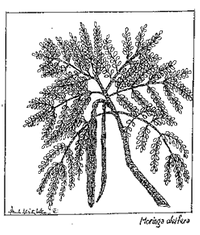 solution for making pure soy flour without any nasty taste--remove the hulls (skin). The flour tastes like chocolate. It keeps fresh for at least one month under our conditions. It is true that the milk does not keep long, but this is the case with any milk."
solution for making pure soy flour without any nasty taste--remove the hulls (skin). The flour tastes like chocolate. It keeps fresh for at least one month under our conditions. It is true that the milk does not keep long, but this is the case with any milk."
MORINGA AND CAROTENE. Dr. C. E. Peterson wrote, "I have removed fresh moringa leaves and left them overnight in my greenhouse, where they very promptly dry and can be rubbed over a screen to make a powder. The fresh weight value of beta-carotene is about 88 ppm and the dried leaves will be about 300 ppm, equal to some of our best high-carotene carrots.
"Even if addition to rice were to be limited to a teaspoon or so without any detectable flavor change, if it were done 2-3 times a day every day it could be a very substantial source of vitamin A where deficiency is causing blindness and other serious health problems."
I would add that if people eat soups, substantially more of this powder could be added. Joel Matthews in Niger says people there preserve dried moringa leaves (not crushed) for use during the dry season as a food. They use it in their sauces. One popular food is a mixture of leaves and peanut press cake.
Dr. Warwick Kerr in Brazil wrote, "Concerning moringa, Drs. Rodrigues, Godoi and I tested the leaves and found them to contain 22,000 units of vitamin A per 100 g, more than reported in the literature [Ed: my sources list 11,500]. This means that one glass of leaves gives the daily dosage of vitamin A to 10 people!"
LEAF CONCENTRATE (LC) is an extremely nutritious food used to alleviate malnutrition. The process of making LC separates the protein, vitamins, and minerals from the fibrous portion of fresh green leaves. LC can be made from by-product leaves of commercial vegetables (beets, broccoli, etc.) or even from productive forages or cover crops not normally used as human food. Incorporated into local recipes, it boosts the nutritional content of a variety of foods.
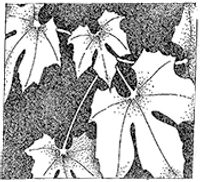 LC is very rich in vitamin A, iron, calcium, high-quality protein, and other key dietary elements. Green leaves are very efficient producers of these nutrients, and leaf products can be the lowest cost source of iron and vitamin A, critical nutrients often missing in poor diets. LC technology is most appropriate for nutrition programs with groups of children, pregnant or nursing women, or elderly people who suffer from dietary deficiencies. For a community project designed to supplement children's diets, mechanized equipment costs about US$1500.
LC is very rich in vitamin A, iron, calcium, high-quality protein, and other key dietary elements. Green leaves are very efficient producers of these nutrients, and leaf products can be the lowest cost source of iron and vitamin A, critical nutrients often missing in poor diets. LC technology is most appropriate for nutrition programs with groups of children, pregnant or nursing women, or elderly people who suffer from dietary deficiencies. For a community project designed to supplement children's diets, mechanized equipment costs about US$1500.
The basic process for making LC is to harvest and wash fresh leaves, grind them to a pulp, press juice from the pulp, bring the juice to a boil, separate out the curds which form in the heated juice, and press the liquid out of the curd. The solid portion of the mild-flavored curd is the leaf concentrate, which can be added to traditional recipes fresh or preserved in various forms. David Kennedy of Leaf For Life (see below) visited ECHO and prepared some pasta using LC made from broccoli leaves (in a household blender) and flour; even the staff who ate only a small portion of this (green) pasta for lunch did not feel hungry for the rest of the afternoon due to the high protein content of the leaf concentrate.
One difficulty in introducing LC-enriched foods is that the concentrate imparts an intense green color to the foods. Considerable work on recipe development has been helpful. One recipe which can substantially increase the leaf nutrient intake by children takes advantage of the bright color: green LC lemonade. To make the syrup, dissolve two kilograms of sugar and 40 g of salt in 1 liter of lemon juice. Mix this into 1 kg of moist LC. The mixture is ground or blended in a high speed mixer until smooth, then bottled. The concentrate is stable for months. Prepare the lemonade by mixing 30 ml of syrup in 200 ml of water. Combining the LC with a good source of vitamin C improves the body's absorption of the leaves' iron as well. A pitcher of LC lemonade made from moringa leaves was served at a staff dinner at ECHO. Most people seemed surprised at how tasty it was, though a few added extra sugar to reduce a "green grassy taste."
It is important to remember that not every leaf is suitable for LC production. David Kennedy states that "many edible leaf crops such as Basella alba [Malabar spinach], sweet potatoes, chaya, okra, lettuce, and many cucurbit family leaves do not work well. Leaves that are too wet or dry (above 90% or below 80% water) don't usually work well in the LC process. Neither do leaves that are acidic like sorrel or dock [Rumex sp.]; mucilaginous leaves like Basella alba, purslane [Portulaca oleracea] or roselle [Hibiscus sabdariffa].
"A fairly large number of edible leaves, such as sweet potatoes and mulberry, form a curd that is very fine and hard to separate. In some leaves, like cassava, phenolic compounds combine with proteins when the leaves are pulped and render the protein much less available to the body. Amaranth consistently gives lower yields of LC than leaves from legumes like alfalfa, cowpeas, peas, berseem clover or common beans or from wheat. Amaranth typically makes a fine curd that is difficult to separate in filter cloth.
"[Disagreeable] taste often has to do with poorly made LC that is either burnt during coagulation, made from partially spoiled leaves, has spoiled during storage, or very often was inadequately pressed. When the moist curd is not pressed to about 60% moisture there are often strong flavors from saponins or other antinutritional substances like oxalic acid and nitrates remaining in the curd. ...When the leaves are well pulped and pressed, the residual fiber is pale green in color and far too fibrous to make an acceptable human food."
Very small scale LC production without some mechanization is generally not feasible because of the very high labor demands on women. LC yields are substantially lower when leaves are pulped and strained by hand compared to mechanical grinders and presses. About 50 g of LC may be produced from 1000 g of fresh leaves, and "a fair amount of that will be lost sticking to the pan or clinging to the filter cloth. Making tiny amounts of LC involves a lot of clean-up relative to the benefit. Effective LC programs will necessarily have powered leaf grinding equipment...for sufficient cell rupture, and at least a manual hydraulic press for adequate separation of the juice from the fiber and of the curd from the whey.
"I also think they need to operate on a larger scale; probably processing a minimum of 100 kg of fresh leaf crop per day and more likely 500 or 1000 kg per day. These projects are most likely to succeed where there is commercial production of leguminous forage crops such as alfalfa, berseem, or cowpeas that can be used for preparing LC. The issues of quality control, preservation of the LC, economic use of the fiber, and distribution become much more important as one moves from a  domestic to a village or cooperative level of production.
domestic to a village or cooperative level of production.
"A project processing a ton of leaf crop per day should be able to provide about 3300 children with 6 g of dried LC or 15 g of fresh LC per day. This can make a genuine contribution to community health, but it requires some infrastructure, capital, and organization. In many villages where malnutrition is prevalent, conditions don't indicate that LC is likely to be a cost-effective food for nutrition intervention. In many of these areas, simpler techniques to increase consumption and improve utilization of leaf crops will probably be more appropriate. These techniques include better leaf crop selection, and improved methods of blanching, drying, and grinding of leaves, as well as innovative uses of dried leaf powders."
The organization Leaf For Life (called Find Your Feet in the UK) has been investigating and promoting LC for improved nutrition in tropical villages for thirty years. They also work with simpler techniques to better utilize leaf crops for food enrichment, such as drying leaves in ways that maintain more of their nutrients. They have a comprehensive, experience-based "Field manual for small scale leaf concentrate programs" (192 pp.) which details processing of LC, basic nutrition, information for evaluating and growing various leaf crop species, economic considerations in organizing a LC program, and recipes from around the world. The manual is available in English (Spanish translation in process) for US$20 within the US/$25 overseas surface mail from Leaf For Life, 260 Radford Hollow Road, Big Hill, KY 40405, USA; tel/fax: 606/986-5418. In the UK, contact Find Your Feet, 37/39 Great Guildford St., London, SE1 0ES; fax 44 1 71 261 9291.
VALOR NUTRITIVO Y USOS EN ALIMENTACION HUMANA DE ALGUNOS CULTIVOS AUTOCTONOS SUBEXPLOTADOS DE MESOAMERICA, by FAO. 115 pages, Spanish only. The book was written to help professionals working in agriculture, food science, and nutrition promote Mesoamerican crops to contribute to the nutritional and economic development of the region. It provides a brief overview of native Central American fruits, vegetables, roots and tubers, and cereals. Each plant receives a two-page description with plant family, scientific and common names, nutritional value, uses, geographic distribution, morphological description, and areas of needed research. Information on known toxicities of some of these plants was lacking; for example, no reference to toxicity was given in the description of chaya, which contains cyanide. Each plant has an accompanying color picture.
As a nutritional guide, this book does not offer much information on the indigenous uses or agricultural practices for the described plants. It is a good introduction to anyone interested in becoming familiar with native Central American plants and their nutritional contribution to the diet. Available free upon request from Dr. Cecilio Moron, Oficial Regional de Pol¡tica Alimentaria y Nutricion, Oficina Regional de la FAO para America Latina y el Caribe, Casilla 10095, Santiago, Chile; fax (56-2) 2182547.
TOXICITY AND FOOD SECURITY: A review of health effects of cyanide exposure from cassava and of ways to prevent these effects. For several years I have been on the lookout for something that could provide a perspective on this important question. Many thanks to Dr. Hans Rosling for sending the 31-page booklet with the above title that he wrote for UNICEF. It is just what I had hoped to find. The subject is so important that I have summarized much more of the material than in a normal review. I include the extra detail so you will be able to anticipate when conditions such as dietary limitations,  economic changes or social turmoil might cause a problem to suddenly appear.
economic changes or social turmoil might cause a problem to suddenly appear.
Dr. Rosling does not like the statement "cassava contains cyanide." A food that contained pure hydrogen cyanide could be easily detoxified (it would be driven off as a gas by cooking). If any free cyanide is present in cassava, it can easily be driven off into the air by temperatures over 28 deg.C (82 deg.F).
The "cyanide" in cassava is actually a complex and very stable molecule called linamarin, one part of which is a cyanide molecule. If that part of the molecule is broken off it will become cyanide. Compounds such as this that produce cyanide when broken down are called "cyanogenic" compounds. Some cyanogenic compounds are broken down by boiling. For example, although chaya leaves contain a cyanogenic compound, the cyanide is driven off by boiling for 5 minutes.
Unfortunately the cyanogenic compound in cassava is largely unaffected by boiling. Boiling whole pieces of cassava does little to reduce the danger of cyanide poisoning (although boiling fermented or grated cassava will remove most of the cyanide, as we will see later).
Linamarin is not itself toxic. If some of it is absorbed from the gut into the blood it is probably excreted unchanged in the urine. The "cyanide" in linamarin can be liberated in two ways. First, enzymes secreted by microbes in the gut can decompose linamarin, liberating cyanide in the process. Second, certain enzymes in the cassava root itself can liberate cyanide from linamarin. In the intact plant, these enzymes never get a chance to degrade linamarin because they are stored in separate places. But when the root structure is disrupted by grating or fermentation, the two come into contact and cyanide is liberated (and will evaporate at temperatures of 28 deg.C or higher).
I am preparing this review while visiting a major cassava-growing area in the Amazon Basin of Brazil. It is interesting to fit observations about farmers' practices into the understanding provided by the book. For example, I am told that the roots are fermented and/or grated (which puts the enzyme and linamarin together), then washed with water and squeezed. Free cyanide is washed out in the water. As the water is left to stand, tapioca settles to the bottom. If a hog or other animal drinks this water, unless it is cooked or considerable time has elapsed, they reportedly can die quickly from the dissolved cyanide. There would be very little cyanide nor linamarin remaining in either the tapioca or the ground, dried cassava, which are consumed in large amounts along with fish.
"Considerable cassava consumption has developed in some areas using processing methods like sun drying, which are very ineffective in removing cyanide. This has probably been possible because initially only the less toxic sweet varieties were used. When these varieties were later replaced by more productive toxic varieties, the established processing practices may suddenly have become insufficient. ... this is probably the case in many cassava growing areas of East Africa. ... sun drying for long periods is not fully efficient, although levels will be lower than after only a few days of drying."
"From the toxicological aspect, strict adherence to the method is as important as the type of method. Soaking in water ... as well as grating and sack-fermenting processes ... are effective as long as the soaking or fermenting steps are not shortened and fermentation conditions are not changed. Sun drying, if performed according to traditional practices, should be extended over several weeks. Populations using prolonged sun drying probably rely on infestation of insects in the roots to achieve a sufficient removal of cyanide.
What if there is an emergency situation in which the water for soaking or some necessary equipment is lacking? A method emerging in coastal Tanzania and Mozambique and Rwanda which "is probably an appropriate and effective way of reducing the cyanide" is called dry fermentation. "A pile of peeled root pieces is covered with leaves or peels for 3-4 days, after which each root piece is completely covered by a black mould growth. The root pieces are dried in the sun and as much of the mould is removed as possible. These pieces are finally consumed after pounding. Unfortunately this method seems to result in a very high exposure to aflatoxins from the mould growth...aflatoxin exposure must thus also be considered as a possible side-effect when cassava provides food security in drought-affected areas." Aflatoxins cause liver damage and are powerful carcinogens.
What happens to cyanide in the body? The body is protected from cyanide in two steps. The blood contains a substance which can, within minutes, bind up to 10 mg of cyanide. This is then taken to the liver and detoxified in a process that takes a few hours.
If more than 10 mg of cyanide is consumed, but not enough to be fatal, it is converted to a far less toxic substance called thiocyanate. The thiocyanate is eventually excreted in the urine. This detoxification process requires the element sulfur, which is obtained from protein in the diet. In protein deficient diets the detoxification process ceases to operate. So lack of protein in the diet accentuates the toxicity of cassava. "It should be noted that considerable amounts of fish are consumed in areas of the Amazon, the Congo basin and southern India where cassava has been established as the dominating staple for centuries."
If other food is not available, "an adult will consume daily about ... 0.5 kg dry (1.5 kg wet) weight of cassava." "The newly developed high-producing varieties with less cyanide-yielding capacity still contain 50-100 mg of cyanide per kg of fresh weight. This amount will easily be removed by processing, but if roots are consumed unprocessed, even these varieties may cause intoxication." ["Intoxication" is medical terminology for "have a toxic effect."]
Diseases related to cassava toxicity: immediate symptoms. Symptoms usually occur 4-6 hours after a meal and consist of vertigo (dizziness), vomiting, collapse and, in some cases, death within 1-2 hours. Antidotes are effective, safe and cheap. Intravenous injection of thiosulfate will increase the sulfur available to convert cyanide to thiocyanate. Nitrite acts more rapidly but must be handled with care as an overdose is itself toxic.
Cyanide intake from cassava is probably a factor in two types of paralysis. In tropical ataxic neuropathy, one of the sensory tracts in the spinal cord is damaged. This results in an uncoordinated gait called ataxia. It occurred in Nigeria, mostly in adult males, with successive occurrences over several years. High cyanide intake with low protein diets were suggested causes.
Epidemic spastic paraparesis occurs mainly among women and children. It permanently cripples the victim "from one day to the next" [in a 24 hour period?] by damaging parts of the spinal cord that transmit signals for movement. Muscles are not flaccid, as in polio, so the legs usually support affected persons sufficiently to let them stand, especially if supported by a stick. Walking is often uncontrolled jerks. Outbreaks have been reported in two locations in Zaire during the dry season and during a drought in one location each in Tanzania and Mozambique.
In each of these four cases cassava was the only food available in quantity and roots were inefficiently processed. This disease has never been reported from a population that did not consume cassava, nor from populations eating balanced diets.
In Mozambique 1102 people were stricken. Cassava was the only food due to a drought [hence no protein for the body's own detoxification process]. Once other foods were gone, they did not have enough processed cassava to replace them. Also the people wanted to leave the roots in the ground as long as possible so that they would grow bigger. When they finally harvested, the people had no time for the lengthy sun-drying process. Studies on this population indicated "that acute intoxication may appear when cyanide intake reaches 30 mg in 24 hours."
Health workers should be aware of the following possible causes of cyanide poisoning: 1) varieties that are normally sweet may produce high levels of linamarin under adverse conditions; 2) a new, but toxic, variety may be introduced to the market and surprise people; 3) hungry, unsupervised children have been known to eat toxic roots in spite of their bitterness; and 4) cassava is sometimes introduced without adequate training in processing methods.
Diseases related to cassava: delayed symptoms. Other diseases develop only after exposure to cyanide over a long period of time. Continuous exposure to insufficiently processed cassava can lead to goiter and cretinism. This problem is especially prevalent in Africa. The thyroid gland, situated in front of the neck, is not normally visible. Its main function is to produce iodine-containing hormones that 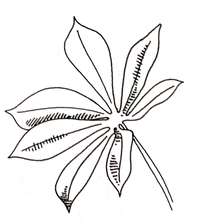 regulate body metabolism. If the diet contains too little iodine the thyroid gland becomes larger so as to be more efficient in extracting what little iodine is in the blood. Some children born to iodine-deficient mothers suffer from cretinism (mental retardation and stunted growth).
regulate body metabolism. If the diet contains too little iodine the thyroid gland becomes larger so as to be more efficient in extracting what little iodine is in the blood. Some children born to iodine-deficient mothers suffer from cretinism (mental retardation and stunted growth).
How is inadequately processed cassava responsible? The thiocyanate produced when cyanide is detoxified (see above) interferes with uptake of iodine by the thyroid gland. Fortunately this interference can happen only when iodine intake is already low, below 200 micrograms per day. Populations in northern Zaire with very low iodine in the diet and who regularly ate inadequately processed cassava suffered from severe endemic goiter and a high prevalence of cretinism. When iodine supplements were used the goiter problem decreased considerably even though the cassava was still not adequately processed due to adverse conditions.
Do all varieties of cassava contain cyanide? The hundreds of cassava varieties are grouped according to taste into bitter and sweet. The bitter varieties generally have more linamarin than the sweet, but there is no clear-cut division into the two groups. "Cassava-growing peasants plant several varieties. The sweet ones in smaller amounts are eaten as snacks or cooked fresh as vegetables. The bitter varieties are grown in large quantities to serve as staple food after processing."
In most cassava-growing areas the bitter and more toxic varieties have been found to be more productive, probably because of the toxicity. For example, monkeys and wild pigs will not feed on toxic varieties. "Peasants often plant small amounts of sweet varieties in the center of a field of toxic varieties" to keep animals from eating the former.
"Breeding programs should continue to take cyanide levels into consideration, but so far no high yielding variety has been found that makes processing unnecessary." "Even `high-yielding low-cyanide' varieties developed by IITA in Nigeria have a cyanide-yielding capacity of about 5-10 mg of cyanide per 100 g of fresh weight. ...consumption of these new varieties without any processing may still result in considerable cyanide exposure. ... strict adherence to efficient processing methods is still needed if large amounts of roots from these new varieties are consumed."
Dr. Rosling has offered copies of his book Cassava Toxicity and Food Security free of charge as long as they are available. Write him at International Child Health Unit, Dept. of Pediatrics, S-751 85 Uppsala, Sweden.
An update from Dr. Rosling. Three recent articles give additional details on the occurrence of spastic paraparesis in the Bandundo region of Zaire (110 live and 24 dead cases). The start of these outbreaks in 1974 coincided with the completion of a new tarmac road to the capital, which facilitated the transport of cassava and made it the main cash crop. "The affected population consumed flour made from short-soaked (one day) cassava roots and thus had high dietary exposure to cyanide (urinary thiocyanate in 31 children was 757 vs. 50 units for a population where cassava had been soaked for the normal three days)."
"The reason for processing shortcuts ... [is that cassava is] exclusively produced and processed by women in very poor households. Roots are short-soaked when women are in a `hurry' to gain cash."
SWEET AND BITTER CASSAVA AND CYANIDE CONTENT. Dr. M. Bokanga writes in the March 1993issue of IITA Research that "varieties of cassava classified as sweet may have a high cyanogenic potential and those classified as bitter may be low." He measures cyanide as "cyanogenic potential" because pure cyanide does not occur in cassava--it is produced upon processing or eating. A panel rated several cassava varieties as bitter or nonbitter. Taste was not a reliable indicator of cyanogenic potential. Nonbitter varieties ranged from 0.91 to 10.6 mg cyanide per 100 g fresh weight of cassava. The range for bitter varieties was 5.0 to 39.9 mg.
Boiling is not an adequate method for detoxifying cassava, but it does reduce the toxin, according to the authors. "Boiling cassava roots, which is considered minimal processing, reduces the cyanogenic potential by at least half." This conflicts with the book Toxicity and Food Security reviewed above. Other processing methods can reduce it by more than 90%.
ARE RAW VEGETABLES MORE NUTRITIOUS THAN COOKED ONES? People taking the educational tour at ECHO often ask, "Can this vegetable be eaten raw?" The unexpressed implication may be that raw vegetables are better for you. Delia Hammock, registered dietitian and nutrition editor for Good Housekeeping magazine says this is not necessarily the case. "While it's true that overcooking reduces the nutritive value of all foods and even moderate heat can destroy certain vitamins, raw foods are not always more nutritious. Some raw foods contain natural substances that actually block the digestion of nutrients or interfere with the absorption or use of vitamins. Cooking inactivates these nutrient blockers." There are also many examples of toxic substances in plants that are detoxified by cooking.
In addition, the digestibility of many foods is improved as heat alters their physical structure. "Cooking carrots breaks down the cell walls making more of the carotenes available for absorption by the body. While on average only 5 percent of the beta-carotene is absorbed from a raw carrot, cooking makes 25-30 percent available. This is a 5-6 fold increase. Pureeing cooked carrots boosts absorption even more."